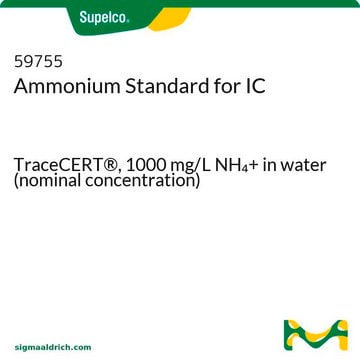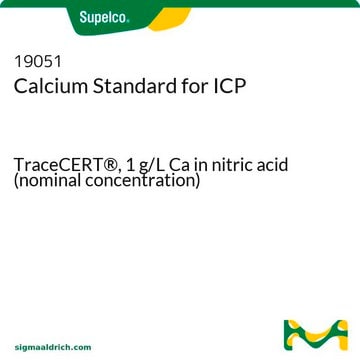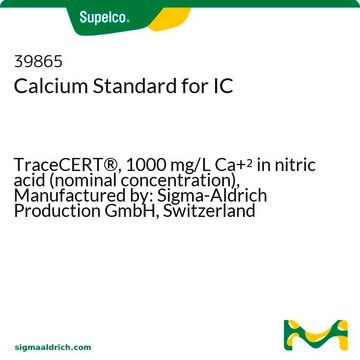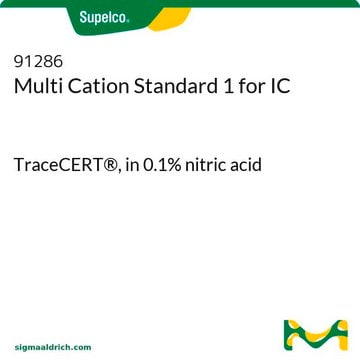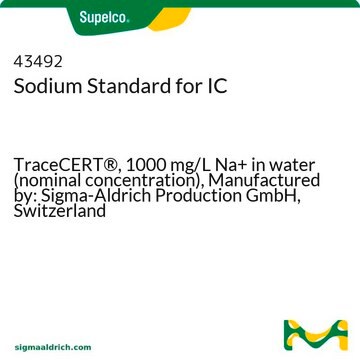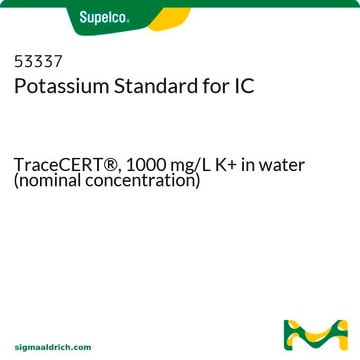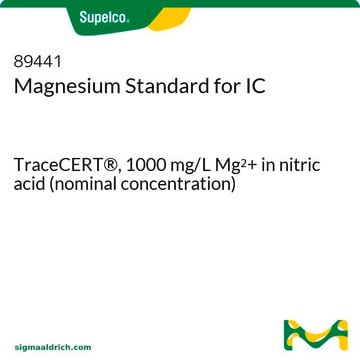55517
Acide méthane sulfonique solution
0.1 M CH3SO3H in water (0.1N), eluent concentrate for IC
Synonyme(s) :
Methanesulfonic acid solution
Se connecterpour consulter vos tarifs contractuels et ceux de votre entreprise/organisme
About This Item
Formule linéaire :
CH3SO3H
Numéro CAS:
Poids moléculaire :
96.11
Numéro Beilstein :
1446024
Numéro MDL:
Code UNSPSC :
12161700
ID de substance PubChem :
Nomenclature NACRES :
NB.21
Produits recommandés
Niveau de qualité
Concentration
0.1 M CH3SO3H in water (0.1N)
Technique(s)
ion chromatography: suitable
Chaîne SMILES
CS(O)(=O)=O
InChI
1S/CH4O3S/c1-5(2,3)4/h1H3,(H,2,3,4)
Clé InChI
AFVFQIVMOAPDHO-UHFFFAOYSA-N
Vous recherchez des produits similaires ? Visite Guide de comparaison des produits
Description générale
This eluent concentrate for ion chromatography is determined by potentiometric titration. Content and expiry date can be found on the certificate.
Application
- Design of a new nanocomposite based on Keggin-type [ZnW(12)O(40)](6-) anionic cluster anchored on NiZn(2)O(4) ceramics: Explores the synthesis of advanced materials using Methanesulfonic acid, contributing to developments in energy storage and catalysis technology (Rezvani et al., 2024).
- Nanosuspensions in ophthalmology: Overcoming challenges and enhancing drug delivery for eye diseases: Discusses the role of Methanesulfonic acid in the formulation of nanosuspensions, enhancing therapeutic efficiency in ophthalmologic applications (Fathi-Karkan et al., 2024).
- Building Flame-Retardant Polymer Electrolytes via Microcapsule Technology for Stable Lithium Batteries: Methanesulfonic acid may be utilized in the synthesis of flame-retardant materials for safer lithium battery technologies, addressing critical needs in electronic manufacturing (Zhang et al., 2024).
- Catalysts for C-N coupling in urea electrosynthesis under ambient conditions from carbon dioxide and nitrogenous species: Highlights the application of Methanesulfonic acid in developing catalysts for green chemistry processes, particularly in the efficient synthesis of urea from environmentally benign sources (Yang et al., 2024).
Liaison
Visit the IC Portal to learn more
Notes préparatoires
Prepared with methanesulfonic acid and high purity water (18.2 MΩ, 0.2 μm filtered)
Produit(s) apparenté(s)
Réf. du produit
Description
Tarif
Code de la classe de stockage
12 - Non Combustible Liquids
Classe de danger pour l'eau (WGK)
nwg
Point d'éclair (°F)
Not applicable
Point d'éclair (°C)
Not applicable
Équipement de protection individuelle
Eyeshields, Gloves
Choose from one of the most recent versions:
Déjà en possession de ce produit ?
Retrouvez la documentation relative aux produits que vous avez récemment achetés dans la Bibliothèque de documents.
Les clients ont également consulté
Renata Solarska et al.
Nanoscale, 4(5), 1553-1556 (2012-02-01)
Nanostructuring of semiconductor films offers the potential means for producing photoelectrodes with improved minority charge carrier collection. Crucial to the effective operation of the photoelectrode is also the choice of a suitable electrolyte. The behaviour of the nanostructured WO(3) photoanodes
Cassandra J Gaston et al.
Environmental science & technology, 44(5), 1566-1572 (2010-02-04)
Dimethyl sulfide (DMS), produced by oceanic phytoplankton, is oxidized to form methanesulfonic acid (MSA) and sulfate, which influence particle chemistry and hygroscopicity. Unlike sulfate, MSA has no known anthropogenic source making it a useful tracer for ocean-derived biogenic sulfur. Despite
Neal W Sach et al.
Organic letters, 14(15), 3886-3889 (2012-07-18)
A general synthesis of aryl ethers from primary and secondary alcohols and aryl mesylates is presented. The reaction proceeds via a sulfonyl-transfer mechanism. In this paper, we compare the sulfonyl transfer reaction to Mitsunobu ether formation. The reaction can be
Chris Twelves et al.
Breast cancer research and treatment, 148(3), 553-561 (2014-11-09)
Data from two phase 3 studies of eribulin were pooled in analyses initially requested by the European Medicines Agency to assess whether specific patient subgroups, previously treated with an anthracycline and a taxane, benefited from eribulin. Study 305/EMBRACE included women
Claudio Pettinari et al.
Inorganic chemistry, 50(21), 11173-11183 (2011-10-18)
Five new silver(I) complexes of formulas [Ag(Tpms)] (1), [Ag(Tpms)(PPh(3))] (2), [Ag(Tpms)(PCy(3))] (3), [Ag(PTA)][BF(4)] (4), and [Ag(Tpms)(PTA)] (5) {Tpms = tris(pyrazol-1-yl)methanesulfonate, PPh(3) = triphenylphosphane, PCy(3) = tricyclohexylphosphane, PTA = 1,3,5-triaza-7-phosphaadamantane} have been synthesized and fully characterized by elemental analyses, (1)H, (13)C
Notre équipe de scientifiques dispose d'une expérience dans tous les secteurs de la recherche, notamment en sciences de la vie, science des matériaux, synthèse chimique, chromatographie, analyse et dans de nombreux autres domaines..
Contacter notre Service technique
